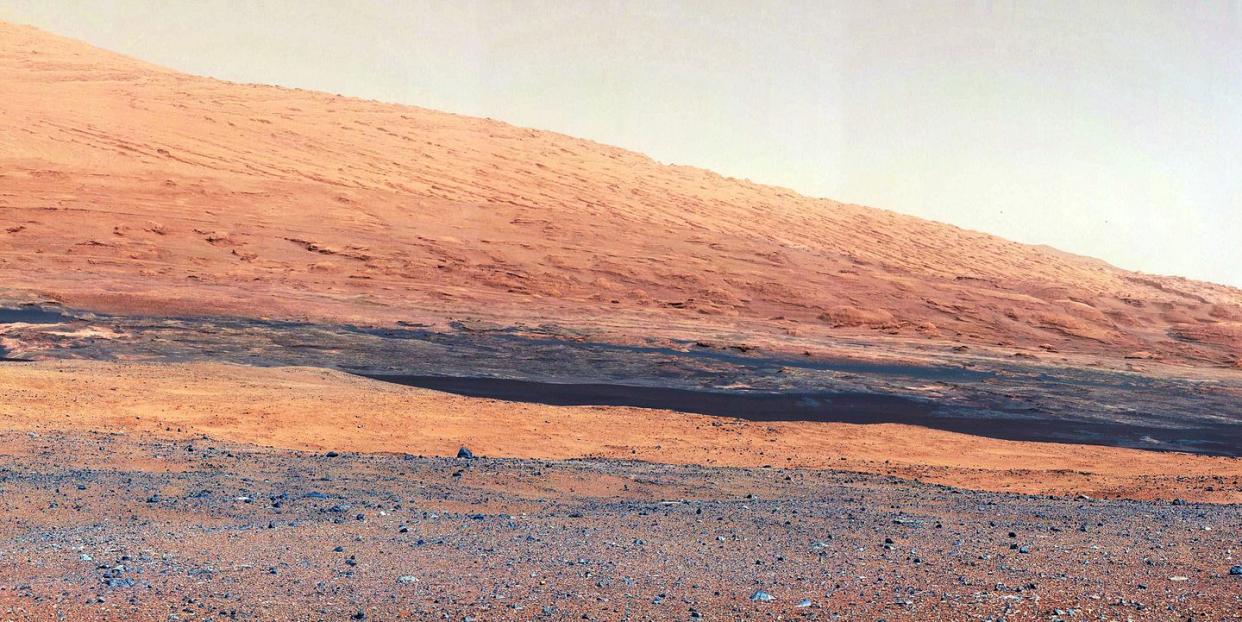Scientists Believe 70 Percent of Ancient Martian Lakes Have Yet to Be Discovered

"Hearst Magazines and Yahoo may earn commission or revenue on some items through the links below."
Our ability to look at ancient lakes on Mars is limited to only the largest of lakes, a new study suggests.
Seventy percent of Earth’s lakes are smaller than those we’ve looked at on Mars. The red planet could likewise have that many undiscovered lakes.
Exploring the sediment in lake beds offers up fossilized clues to the existence of life.
Scientists excited about exploring former lakes on Mars may have more opportunities to investigate traces of life there than previously thought.
A new study published in Nature Astronomy suggests that our knowledge of Martian lakes accounts for only the planet’s largest lakes—leaving numerous others still undiscovered. Most of the early climate geological record still lies beneath smaller ancient lakes. Mars may have many such paleolake basins, no longer brimming with water, but embedded with mineral deposits that could contain signatures of past life.
🔭 You love the cosmos. So do we. Let’s nerd out over it together.
“We know of approximately 500 ancient lakes deposited on Mars, but nearly all the lakes we know about are larger than 100 km2 [60 square miles],” says Joseph Michalski, University of Hong Kong geologist and lead author of the study, according to Phys.org. “But on Earth, 70 percent of the lakes are smaller than this size, occurring in cold environments where glaciers have retreated. These small-sized lakes are difficult to identify on Mars by satellite remote sensing, but many small lakes probably did exist.”
Could most of Mars’s former lakes still lie waiting to be discovered? Michalski believes it is possible. And the data obtained from the sediment of those lakes could prove critical to understanding the past climates—and possible life—on the planet. Martian palaeolakes are “undeniably among the top targets” for future sample gathering, the study authors write. Still, “many questions surrounding prospects for biogenesis and biological productivity in short-lived lakes and transient warm climates on an otherwise cold planet remain.”
Lakes can form—whether on Earth or Mars—via diverse climate events and geology, including rainfall, snowmelt, rivers, and groundwater. Over time, the lake-bed sediments that accumulate often retain the signs of life and climate, both current and past. Deposits in palaeolake basins contain clay minerals rich in iron and magnesium, as well as other compounds such as sulfates, silica and chlorides “that potentially preserve the characteristics of the ancient atmosphere and climate,” the authors write.
The study of Martian lakes could be quite similar to the way we plumb our own planet’s ancient lakes in order to reconstruct their former geology and associated biology, according to the researchers. For example, single-celled microorganisms on Earth call even harsh environments such as the Dead Sea home. Molecular fossils buried in sediment show clear evidence of life there, stretching back thousands of years. “Although we know there’s a ton of diversity in the microbial biomass, it’s always exciting to see what strategies these microbial communities use to survive in different environments,” Yuki Weber, a biochemist at Harvard University, tells Scientific American about the Dead Sea research. “There’s still a lot that has to be learned about the microbial metabolism.”
When it comes to lakes, comparing Earth to Mars isn’t that far-fetched. NASA’s Opportunity rover found gypsum on Mars in 2011, the same mineral found in Dead Sea sediments, opening possibilities that as Mars warmed, oceans and lakes evaporated to resemble the Dead Sea.
The scientists believe Mars’s dried-up lakes could date back to 4 billion years ago and may have only existed for a fraction of that time—maybe 100,000 years at most. But the data may be enough to show that Mars had a warming period. “Because of the lower gravity on Mars and the pervasive, fine-grained soil, lakes on Mars would have been very murky and might not have allowed light to penetrate very deeply,” Michalski cautions, “which could present a challenge to photosynthetic life if it existed.”
As we know from the lake-heavy regions of Earth’s far northern reaches, the prodigious amount of water in lakes offers an ideal setting for life. For however short a time, the same may have been true of the long-lost lakes of Mars.
You Might Also Like
